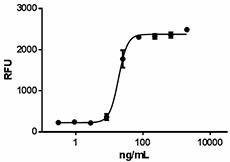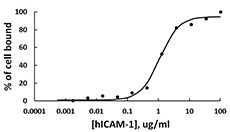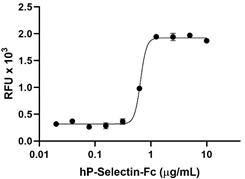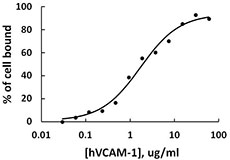- Regulatory Status
- RUO
- Other Names
- SELE, CD62 antigen-like family member E (CD62E), Endothelial leukocyte adhesion molecule 1 (ELAM-1), Leukocyte-endothelial cell adhesion molecule 2 (LECAM2)
- Ave. Rating
- Submit a Review
- Product Citations
- publications

-

Immobilized recombinant human E-Selectin induces adhesion of U937 cells in a dose dependent manner. ED50 for this effect is 15 - 60 ng/mL. Calcein-AM was used to measure the number of adherent cells.
| Cat # | Size | Price | Quantity Check Availability | Save | ||
|---|---|---|---|---|---|---|
| 718702 | 10 µg | $89 | ||||
| 718704 | 25 µg | $176 | ||||
E-Selectin, an adhesion molecule, belongs to the selectin/LECAM family. E-Selectin consists of one Lectin domain and several EGF-like repeats, which are followed by a transmembrane region and a short cytoplasmic tail of 32 amino acids. E-Selectin is only expressed in endothelial cells. Upon activation by TNF-α, IL-1, and LPS, E-Selectin is upregulated at the transcriptional level and reaches the maximal peak at the cell surface in three to six hours. Then the expression level returns to the baseline after 16 to 24 hours. In contrast with P-Selectin, IL-4 suppresses the expression of E-Selectin. E-Selectin binds to its ligand ESL-1, which is a glycoprotein that is expressed in neutrophils. In addition, E-Selectin binds to PSGL-1, which interacts with P-Selectin as well. The interactions between E-Selectin and its ligands initiate cell contact and leukocyte rolling on endothelial cells’ surfaces during inflammation. E-Selectin’s expression is elevated in several types of cancer cells and contributes to cancer metastasis. Thus, in Selectin-deficient mice, metastatic breast cancer cell homing to the lung vasculature is reduced.
Product DetailsProduct Details
- Source
- Human E-Selectin, amino acids (Trp22-Pro556) (Accession# P16581), with a C-terminal human IgG1 Fc and 6-His tag was expressed in CHO cells.
- Molecular Mass
- The 774 amino acid recombinant protein has a predicted molecular mass of approximately 85.56 kD. The DTT-reduced and non-reduced protein migrates at approximately 100 and 200 kD respectively by SDS-PAGE. The predicted N-terminal amino acid is Trp.
- Purity
- >95%, as determined by Coomassie stained SDS-PAGE.
- Formulation
- 0.22 µm filtered solution is in PBS, pH 7.2.
- Endotoxin Level
- Less than 0.01 ng per µg cytokine as determined by the LAL method.
- Concentration
- 10 and 25 µg sizes are bottled at 200 µg/mL.
- Storage & Handling
- Unopened vial can be stored between 2°C and 8°C for up to 2 weeks, at -20°C for up to six months, or at -70°C or colder until the expiration date. For maximum results, quick spin vial prior to opening. The protein can be aliquoted and stored at -20°C or colder. Stock solutions can also be prepared at 50 - 100 µg/mL in appropriate sterile buffer, carrier protein such as 0.2 - 1% BSA or HSA can be added when preparing the stock solution. Aliquots can be stored between 2°C and 8°C for up to one week and stored at -20°C or colder for up to 3 months. Avoid repeated freeze/thaw cycles.
- Activity
- ED50 = 15 - 60 ng/mL as measured by the ability of immobilized protein to support the adhesion of U937 cells. Calcein-AM was used to measure the number of adherent cells.
- Application
-
Bioassay
- Application Notes
-
BioLegend carrier-free recombinant proteins provided in liquid format are shipped on blue-ice. Our comparison testing data indicates that when handled and stored as recommended, the liquid format has equal or better stability and shelf-life compared to commercially available lyophilized proteins after reconstitution. Our liquid proteins are verified in-house to maintain activity after shipping on blue ice and are backed by our 100% satisfaction guarantee. If you have any concerns, contact us at tech@biolegend.com.
Antigen Details
- Structure
- Adhesion molecule.
- Distribution
-
Endothelial cells.
- Function
- E-Selectin mediates leukocyte rolling during inflammation.
- Interaction
- Neutrophils and monocytes.
- Ligand/Receptor
- P-selectin glycoprotein ligand-1 (PSGL-1) and ESL-1.
- Cell Type
- Hematopoietic stem and progenitors
- Biology Area
- Angiogenesis, Cell Biology, Immunology, Neuroscience, Neuroscience Cell Markers, Stem Cells
- Molecular Family
- Adhesion Molecules, CD Molecules
- Antigen References
-
1. Vestweber D, Blanks JE. 1999. Physiol. Rev. 79:181.
2. Bevilacqua MP, et al. 1987. Proc. Natl. Acad. Sci. USA 84:9238.
3. Pober JS, et al. 1987. J. Immunol. 138:3319.
4. Thornhill MH, Haskard DO. 1990. J. Immunol. 145:865.
5. Asa D, et al. 1995. J. Biol. Chem. 270:11662.
6. Fries JW, et al. 1993. Am. J. Pathol. 143:725.
7. Hiratsuka S, et al. 2011. Proc. Natl. Acad. USA 108:3725.
8. Tanaka T, et al. 2011. Adv. Mater. 36:H278-82. - Gene ID
- 6401 View all products for this Gene ID
- UniProt
- View information about E-Selectin on UniProt.org
Related FAQs
- Why choose BioLegend recombinant proteins?
-
• Each lot of product is quality-tested for bioactivity as indicated on the data sheet.
• Greater than 95% Purity or higher, tested on every lot of product.
• 100% Satisfaction Guarantee for quality performance, stability, and consistency.
• Ready-to-use liquid format saves time and reduces challenges associated with reconstitution.
• Bulk and customization available. Contact us.
• Learn more about our Recombinant Proteins. - How does the activity of your recombinant proteins compare to competitors?
-
We quality control each and every lot of recombinant protein. Not only do we check its bioactivity, but we also compare it against other commercially available recombinant proteins. We make sure each recombinant protein’s activity is at least as good as or better than the competition’s. In order to provide you with the best possible product, we ensure that our testing process is rigorous and thorough. If you’re curious and eager to make the switch to BioLegend recombinants, contact your sales representative today!
- What is the specific activity or ED50 of my recombinant protein?
-
The specific activity range of the protein is indicated on the product datasheets. Because the exact activity values on a per unit basis can largely fluctuate depending on a number of factors, including the nature of the assay, cell density, age of cells/passage number, culture media used, and end user technique, the specific activity is best defined as a range and we guarantee the specific activity of all our lots will be within the range indicated on the datasheet. Please note this only applies to recombinants labeled for use in bioassays. ELISA standard recombinant proteins are not recommended for bioassay usage as they are not tested for these applications.
- Have your recombinants been tested for stability?
-
Our testing shows that the recombinant proteins are able to withstand room temperature for a week without losing activity. In addition the recombinant proteins were also found to withstand four cycles of freeze and thaw without losing activity.
- Does specific activity of a recombinant protein vary between lots?
-
Specific activity will vary for each lot and for the type of experiment that is done to validate it, but all passed lots will have activity within the established ED50 range for the product and we guarantee that our products will have lot-to-lot consistency. Please conduct an experiment-specific validation to find the optimal ED50 for your system.
- How do you convert activity as an ED50 in ng/ml to a specific activity in Units/mg?
-
Use formula Specific activity (Units/mg) = 10^6/ ED50 (ng/mL)
 Login/Register
Login/Register 












Follow Us